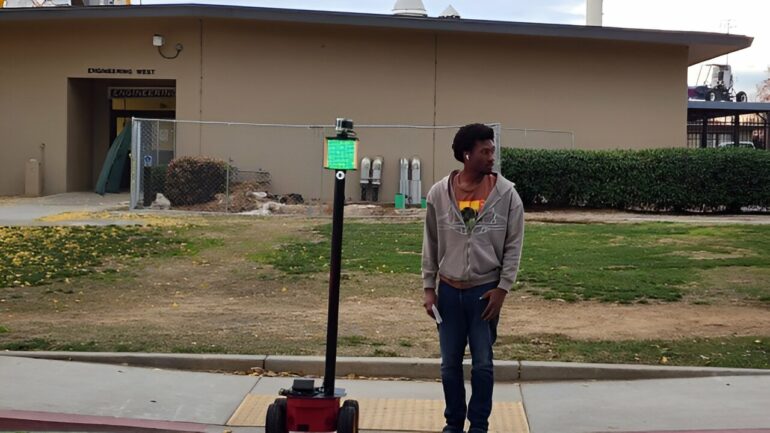by Kristin J. Bender, The Orange County Register
It looks a bit like a small lawnmower, but instead of dual handles, a single black pole with a tablet-sized screen attached rises from the machine.
This robot isn’t wildly talkative like the gold-clad C-3PO from “Star Wars,” but it does have the ability to speak. This simple prototype called CrossBot doesn’t sing or play guitar like Robot from “Lost in Space,” but its human creator says it does possess powerful tools—the ability to protect kids in crosswalks—and the potential to reduce a Bay Area crossing guard shortage.
“It has a 360-degree view of the environment,” said creator Hovannes Kulhandjian, an associate professor in electrical and computer engineering at Fresno State. “This is a very serious device; you have to have a very low probability of error because you are dealing with kids.”
Kulhandjian, who also works with the Mineta Transportation Institute in San Jose, is working on a patent for his CrossBot.
It’s equipped with sensors, including Lidar, a microphone, radar, video camera capabilities, a speaker system and advanced algorithms. In a video demonstration, CrossBot squats at the curb, then rolls out into the crosswalk when traffic is clear.
The robot rolls onto the crosswalk with its screen light red. When an approaching vehicle stops, the screen turns green, signaling to kids waiting at the curb that it’s safe to cross. The robot can also tell a visually impaired person that it’s safe to cross.
Kulhandjian said he came up with the idea for a robotic crossing guard while taking his two young daughters to school in Fresno and seeing teachers filling in as crossing guards when they had work to do preparing for class.
Kulhandjian said he trusts his robot to assist all children, including his own, and that the device has been tested on city streets with a more than 90% accuracy rate for detecting vehicles, cyclists and pedestrians.
But not every parent is sold on the idea.
“I would be livid if a robot replaced our crossing guards,” said parent Kelly Lathrop of Lafayette in an email. “Crossing guards know our kids and keep an eye out in general, they are a highlight of the morning and afternoon. I wouldn’t trust a robot to not malfunction or not get hacked. We need real eyes on these major and minor intersections.”
Angela Roberts, the mother of two young daughters who attend Laurelwood Elementary School in Santa Clara, said she too would be concerned about the reliability of the robot, but she’s also seen a lot of turnover with school crossing guards over the last three years.
Over the last few years, school districts in San Jose, Oakland, Los Altos, San Francisco and Pleasant Hill have all reported a shortage of crossing guards. Many crossing guards were displaced because of distance learning during the pandemic, and some never returned to their jobs, reports show.
“On average, it seems like there is a differently staffed crossing guard every couple months if not weeks. And it’s not uncommon for there to be days where there is no crossing guard at all,” Roberts said. “From my perspective, the challenge of hiring and retaining crossing guards has been ongoing due to its hours and pay. And while the students and families have always been gracious and appreciative of the crossing guards who have been there, the demand for robotic crossing guards may be a good solution.”
While accidents, including pedestrian-related car crashes, are the second-leading cause of death for children under 14, according to the U.S. Centers for Disease Control and Prevention, people on foot of all ages face danger on the street.
The Governors Highway Safety Association, which tracks pedestrian deaths in the United States, found that more than 7,500 pedestrians were killed by drivers in 2022, the latest year that data was available. That was the highest number since 1981, the report said.
These days, robots are used in a variety of ways for many different reasons. They transport goods in storage facilities, load and unload trucks, carry parts to production lines and even deliver packages and make coffee. Robots have been deployed to inspect railways and in airports to handle luggage, help clean facilities and assist with security inspections.
In fact, according to the Robotics Industry Size & Share Analysis Report by Mordor Intelligence, the global robotics market size is projected to reach $95.93 billion by 2029.
Kulhandjian said his robot isn’t meant to take away jobs from humans, but a years-long crossing guard shortage in the Bay Area shows that may not be an issue. While Kulhandjian said he may add additional components to the robot, such as a large red stop sign, he said he believes the device could last a decade and cost a school district about $15,000 to $17,000 to buy.
“CrossBot is designed to complement and enhance human efforts rather than replace them,” Kulhandjian said.
“In many areas, there may not be enough human crossing guards available, especially in regions lacking traffic lights or during times when staffing is limited. CrossBot can fill these gaps, providing additional safety measures during critical times and in high-demand areas.”
2024 MediaNews Group, Inc. Distributed by Tribune Content Agency, LLC.
Citation:
Researcher designs robot to help children cross streets safely (2024, August 10)


